Early on in our journey, I wrote that the Divine could be found in the beautiful North Woods of Wisconsin. As a person who practices yoga and meditation, I believe that God can be reached through a straight spine, a calm mind and a loving, open heart. However, a recent trip to Savannah and its surrounding natural and urban areas proved one thing more: God can visit through the feet. Indeed, Divine Mother spoke to me through the souls (aka “soles”) of my feet — straight from the ground, directly up and through my arches, my legs, my body and my being, lightening my heart and illuminating my mind. I safely can say that the latter is true for the rest of this trio: Savannah, boasting and bursting, is grounded and forward-moving and we felt it. Immense, adorned forests. Ebbing, flowing tides. Long, salty marshes. Abundant, curious wildlife. Integrated, international, hip, historical. Savannah has pretty much anything for anyone. Drive your car, take the bus, ride your bike or put on your walking shoes and choose your own adventure through city, park or island, taking your time if you can. It’s Savannah, y’all, and it speaks to — and through — your soul.
For this family, Savannah, Georgia, in the southeastern U.S was like our Maine destination up north — it called to us as a place that we must visit, and, in due time, we would find our way there. We meandered through bold, diverse Virginia and pushed through the wet and wild Carolinas, crossing bridges and wetlands, island-hopping almost all the way until we landed on Skidaway Island, just southeast of Savannah. We could not have dreamt a more picturesque habitat for us, the forest and the wildlife that call Skidaway Island State Park home, and Savannah proper left us wanting to see and know more. It was all better than anticipated.
I grew up with only a few notions about Georgia — Sherman’s March to the Sea, Georgia as a secessionist state, rampant racism, confederate flags raised high, peaches and peanuts. That’s what happens when one grows up in one place, learning from a book in a classroom or through news on TV: Ideas are planted and fed, or left unattended, until one goes out and sees for oneself. My interest in Georgia began to grow when I met a beloved friend in college from Atlanta. A musician, smart, intellectual, interested, effective and unaffected, he was cool even when he wasn’t. And, yes, I read Midnight in the Garden of Good and Evil, which had me at cemeteries, a drag queen, romantic and idyllic images of the Deep South and, of course, Johnny Mercer. Scot had visited the region as well. We knew that it must be part of the itinerary.
One of our favorite parts about traveling the States is the (re)discovery of Native cultures on our own terms and more in depth than what we ever learned in a classroom, at least for me and Scot. Our education continued in Savannah. Early on, Georgia was inhabited by mound builders, who lived in North America over a five thousand year period leading up to approximately the sixteenth century CE. Although evidence of their dwellings can be found all over North America, it is easy to find them throughout Skidaway Island in Savannah by looking for shell middens. Shell middens are compact piles of discarded oyster shells — and often bones and ceramics — that were thrown behind the dwellings of mound building peoples. The mounds often formed a horseshoe shape, indicating to archaeologists and anthropologists how these early civilizations might have looked. (Wikipedia)

Later on, the area that is Savannah was home to the Guale and Yamasee tribes. Then, it was occupied by members of the Shawnee Nation, who were driven to the region due to European settlement. A semi-migratory group, the Shawnee overtook the Westo’s territory at the head of the Savannah River near Augusta. As an Algonquin-speaking tribe, there were variations of “Shawnee,” such as Shawano, Savano and Savana, which, perhaps, gave rise to the modern territory’s namesake. It is also possible that “Savannah” came from the Spanish “sabana,” which was borrowed from the Taíno “zabana,” or from the Algonquin terms for “southerner” or “salt.” (Wikipedia) In any case, just as the Shawnee pushed out the Westo, colonists pushed out or relocated the Shawnee toward Missouri, Kansas and Oklahoma. But Georgia’s colonial history is much more interesting than usual, and reveals much more than I ever remember learning through text.
One cannot discuss Georgia without mentioning James Oglethorpe. A British general, Member of Parliament, social reformer and philanthropist, Oglethorpe had his own ideas about the Georgia colony and Savannah. Disenchanted with the conditions of English prisons and the grim outlook for those released from prison into urban society, as well as the loathsome environment for sailors, Oglethorpe hoped to create a place for folks to thrive by sending them to the New World. In his mind, this place for reentry into society was Georgia. Oglethorpe devised a plan to establish Georgia through the hands of the impoverished and imprisoned of England.
The Oglethorpe Plan — a multi-faceted, Enlightenment-inspired layout for the settlement of Georgia — would create “agrarian equality,” realized through family farming, social integration and regulated urbanization via limited, granted land ownership of fifty acres. Inhabitants could obtain larger parcels, but only if it was supported by a larger number of indentured servants. Purchased or inherited land was prohibited. The Oglethorpe Plan was also inspired by the Grand Model for the Province of Carolina, but with two major differences: It prohibited slavery and aristocracy. At the heart of the Oglethorpe Plan were social equity and civic virtue, making it the only colony to blend Enlightenment themes of science, humanism and secular government with the fundamental ideologies of the Founding Fathers — that all men are created equal and have the God-given right to pursue life, liberty and happiness. Although this framework would not go exactly as planned, it set the groundwork for a very wonderful and vibrant Savannah in the long run. (Wikipedia)
Oglethorpe was a natural ambassador. After landing in present-day Savannah on the Anne in 1732, he became good friends with Chief Tomochichi of the Yamacraw Nation, a tribe that evolved in Georgia in the early eighteenth century and is significant in Savannah’s history. He negotiated with Tomochichi’s community for land and built forts there to keep an eye on the Spanish to the south. Then, Oglethorpe returned to England to persuade Britain not to include slavery in the Georgia colony after intercepting a letter from enslaved Ayuba Suleiman Diallo of Maryland, who himself had participated in the slave trade in Africa, but found himself captured and enslaved in the New World. The Crown granted Oglethorpe and his Trustees royal charter to the Georgia colony with plans to pursue Enlightenment dreams.
But Savannah was a hot port and a “key contested area” between Spain’s Florida and England’s Carolina, and so the British had other ideas about what to do with Savannah and Georgia. Oglethorpe envisioned that Georgia would inherit England’s “worthy poor” — the hopefully soon-to-be-reformed prisoners and debtors — but the Crown preferred skilled craftsmen from Scotland, as well as other poor, skilled artisan and religious refugees from Switzerland, France and Germany to help with expansion. Many Jewish refugees made their way to Georgia, too. However, Catholics were not allowed into Georgia due to their affiliation with Spain. In fact, Britain made Savannah into an “obstacle” to completely exclude the Spanish, particularly after the Spanish invaded the colony in 1742. Ten years later, after failing to renew monies to support the colony and with Savannah high on the list of priorities, Oglethorpe’s Trustees turned Georgia over to the Crown with a new governor appointed by the king. (Wikipedia, Savannah Carriage Tours)
Britain also had other ideas about slavery. The Crown had outlawed slave labor in the original plan for Georgia, because it believed that runaway slaves could weaken Georgia by heading to St. Augustine, Florida. But rather than escaping to Florida, enslaved people fled to Georgia, enraging folks in the Carolina colony by diluting its workforce. Furthermore, as Georgia’s economy grew, England realized the error of its way by omitting the use of slave labor. Once again, the urge for power and money turned the former salve-free Georgia and its residents greedy, and fueling racism. The colony turned its back on Oglethorpe, and he returned to England, while slavery became legal in Georgia. (Wikipedia)
By 1776, Georgia had joined the other colonies to overthrow British rule during the American Revolution. In 1829, gold was discovered in Georgia, and white settlers seized the opportunity to seek their fortune until the end of the Georgia Gold Rush in 1861. But greed didn’t stop with gold. Settlers also wanted land, particularly from the resident Cherokee Nation, and pressured the government to have it. In 1830, President Andrew Jackson signed into law the perceived-merciful Indian Removal Act, ignoring the Supreme Court’s ruling in Worcester v. Georgia that states could not recreate boundary lines. His predecessor, Martin Van Buren, perpetuated Jackson’s non-compliance of federal law by sending troops into Georgia to displace the Cherokee, better known as the Trail of Tears, during which over four thousand Cherokees died. All of the eastern Native tribes, including all of Georgia’s, were moved to what is now Oklahoma. (Wikipedia)

And so Georgia joined the Confederate side in 1861. Sherman marched to the sea. Almost twenty thousand Georgian’s died. His goal was Savannah, which was the South’s sixth most populous city. However, local authorities surrendered peacefully with Sherman, who marched into the city at dawn on December 21, 1864. Savannah was saved, while Georgia as a whole was the last state to enter the Union after reconstruction. (Wikipedia)
Of course it didn’t end there. White Democrats regained power in the state legislature and passed a poll tax in 1877, which quite literally excluded poor whites and blacks from registering to vote. Then a white primary was created in 1908, denying black folks the vote, even though almost half of Georgia’s population was African-American. This wouldn’t change until the Voting Rights Act was established in 1965. (Wikipedia)
But Savannah had saved itself, and lots of folks were thriving there as it was still a busy and prosperous port town. Yet there is more to it: Savannah had at its core the fundamentals of the Oglethorpe Plan and is lauded as such. The Oglethorpe Plan was revolutionary because it was unique then and now, for it created wards. Wards allowed “for growth in small, interlocking units … of approximately 10 acres.” Furthermore, the plan maximized living space around organized green space, which was to be made public. Finally, and perhaps most importantly, the Oglethorpe Plan nurtured social equality. These factors and the foresight of Savannah’s urban planners-to-come made Savannah what it is today, a city that evolved organically into a diverse community of many people and activities, each with its own identity, working, playing and acting together to make one magnificent city. There is no other example like it in the U.S. It is an easy city to like, love and meander, all due to James Oglethorpe.
And this is exactly what appealed to us. In Savannah, people are together, from various neighborhoods, from all over the country and the world. Nature is included. Everything speaks. Quite unlike our experience in Charleston, which we felt was stuck — conflicted and polite — in a very slow-to-change hamster wheel of pretend, Savannah knows where it was and who it is. We didn’t meet one person from Savannah who disliked it. Every local we encountered had something to offer — a favorite place for sitting, talking, eating, experiencing. Even locals enjoy some of the tourist stuff, like ghost tours, because everything in Savannah is so interesting and enjoyable. What is not to like about a city that is so aware of itself?
We spent most our time at Skidaway Island State Park, but we also visited Tybee Island Beach and, of course, Savannah. There is much to do. But if you go to Savannah, choose your own adventure and just go with it. Make time to take time. You will not be disappointed.
Take a carriage tour. We usually don’t do things like this, mostly because there isn’t enough in a city for us to spend the time and money to do so, but Luna really wanted to take a carriage ride, which is a good idea with a kiddo in tow. We believe that a carriage ride in Savannah is a great way to begin to grasp the history of the city, experience the layout and watch all the people doing various things, such as getting married in a square, riding other random vehicles for city tours, walking or riding bikes, exploring, taking pictures or just being locals. We used Carriage Tours of Savannah and loved it. Our driver was super informed, very goofy and had trained with horses in our home state on Mackinac Island. Totally worth it.
Walk the Squares. If you have the urge and the energy, use a map or an app and walk from green space to green space. Among the twenty-four original squares in Savannah, twenty-two still exist and they are all unique. Most of them (maybe all of them?) contain a statue or a fountain or two. All of them have a place to sit under a giant shady tree. They will take you through the wards of Savannah and, thus, its history. Take a camera and visit the historic buildings and parks. They are everywhere. By the way, inherent in the Oglethorpe Plan was a speed limit that deliberately makes Savannah pedestrian-friendly, so go already. Parking is a breeze.
Eat. There is no way to begin to tell you about food in Savannah. It is considered a foodie city, so there is much to consider. Ask a local or pick a neighborhood and see what it might have to offer. We had food and beer at Moon River Brewing, but our server told us that the best pizza in town was at Vinnie Van Go Go’s at City Market and to eat breakfast at The Breakfast Place in Thunderbolt. But sending you somewhere to eat would be a futile endeavor. You must discover for yourself.
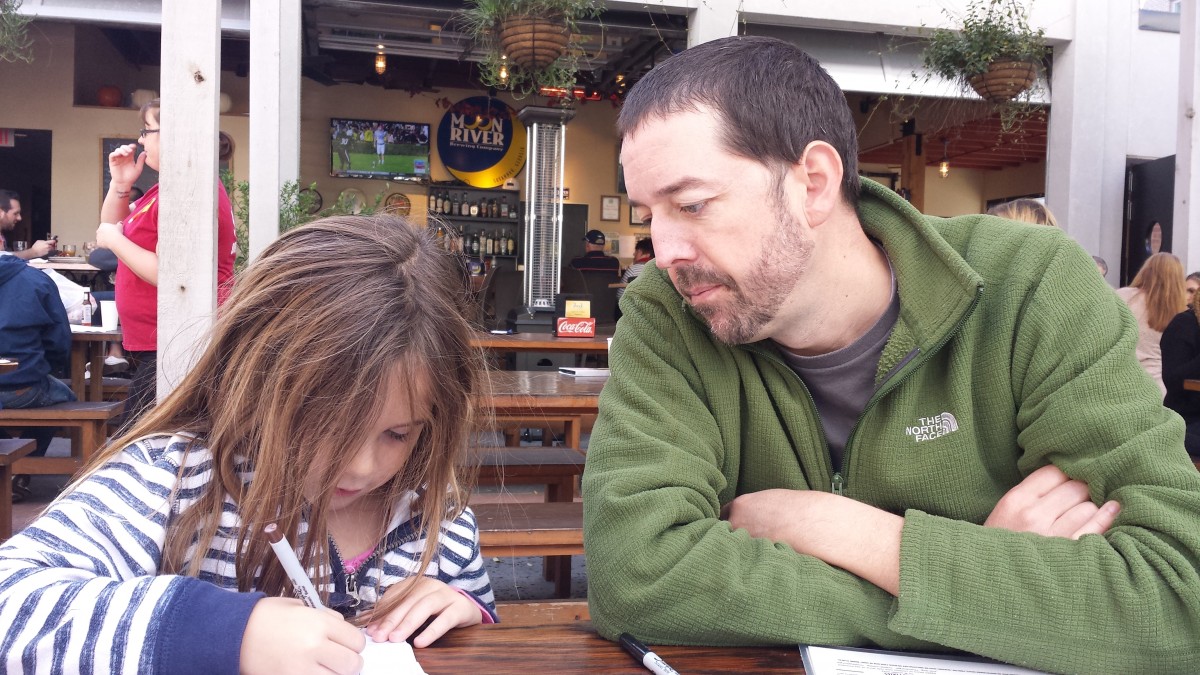
Check Out a Museum, Church or Historic Building. Art and architecture are abundant in Savannah. A site that we missed, because it is only open two days a week, but that we will return to visit is the Pin Point Heritage Museum. It offers a different aspect of a thriving, self-sustaining Gullah community on Skidaway Island. There is also the Girls Scouts First Headquarters, the Andrew Low House and, of course, the stunning Cathedral of St. John the Baptist, and much, much more.
Skidaway Island State Park. I repeat, Skidaway Island State Park. We wrote lots about it.
Tybee Island Beach. This beach is the only beach in town, but you won’t be disappointed. Buses run out to Tybee Island, but a car is the handier of options.
Cemeteries. Taphophiles unite at any of the intriguing cemeteries in Savannah. A tombstone tourist and cemetery enthusiast I am and visited Southern Gothic Bonaventure Cemetery, but there are more options in Savannah. Take your pick and your camera, or just take time to meander the peace and serenity of a cemetery.
Drive the Islands and Intracoastal Bridges. Everyone loves a sunset, but seeing a sunset while driving along the intracoastal bridges from island to island in Savannah is magical. It is also a great way to see the marshes and long docks, as well as the many vistas within Savannah’s coast. One can also see the intracoastal bridge from Skidaway Island State Park — sort of an insider’s view. Delicious.
- Enjoy the Outdoors at Skidaway Island State Park Campground.
- Forsyth Park, Savannah.
- Moon River Brewing.
- Johnson Square, Savannah.
- Luna, Proud of Her New Giraffe.
- City Market, Savannah.
- From the Beer Garden at Moon River Brewing.
- Johnny Mercer Statue at Ellis Square, Savannah.
- Drive-by Carriage Ride Photo Shoot, Savannah.
- Scenes from Bonaventure Cemetery.
- Tybee Island Beach
- Skidaway Island Forest.
- Haitian Monument Statue, Franklin Square, Savannah.
- Fountain at Forsyth Park.
So, you see, Savannah is delightful, full of history and conflict and progress, and a shining star among southern cities. We hope to return again someday. If you go, let us know. We would enjoy hearing about your experience. In the meantime, listen to a little Johnny Mercer. Here is a possible playlist idea — some of my favorites — should you care to croon: “Skylark,” “I Thought About You,” “Goody, Goody,” “Fools Rush In,” “Tangerine,” “Hit the Road to Dreamland,” “Laura,” “Summer Wind,” “Trav’lin Light.”
Oh, so dreamy. Savannah.

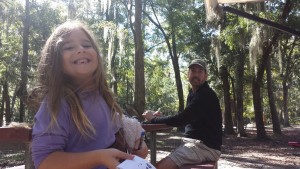
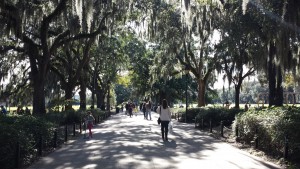
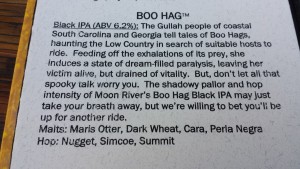




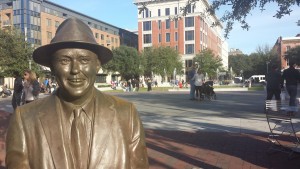


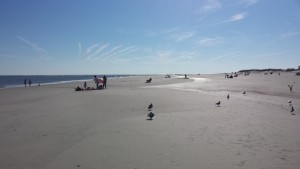




Oh….the depth of your soul, Woman. Your writing leaves me with lingering visual memories and the desire to add Savannah to my personal must-see list. Thank you for the effort you put into writing such interesting and meaningful stories.
Super cool place, lady. You will love it!